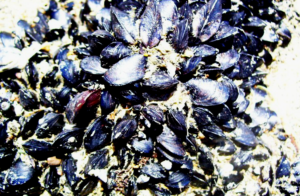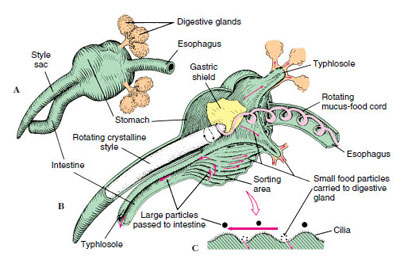
Mussels
Mussels Family Mytilidae
 Mussels are bivalves and like clams and oysters, their shell consist of two hinged halves (valves).
Mussels are bivalves and like clams and oysters, their shell consist of two hinged halves (valves).
The shell outline is longer than it is wide (elongated) and asymmetrical compared with other edible bivalves which are often more or less rounded or oval.
Blue mussels and ribbed mussels are the most common species found in the vicinity of Barnegat Bay
The Intertidal Zone
Intertidal zones exist anywhere the ocean meets the land, from steep, rocky ledges to long, sloping sandy beaches and mudflats that can extend for hundreds of meters.
Four physical divisions, each with distinct characteristics and ecological differences, divide the intertidal zone.
The intertidal zone is the area where the ocean meets the land between high and low tides.
- Spray zone: dampened by ocean spray and high waves and is submerged only during very high tides or severe storms.
- High intertidal zone: floods during the peaks of daily high tides but remains dry for long stretches between high tides. It is inhabited by hardy sea life that can withstand pounding waves.
- Middle intertidal zone: over which the tides ebb and flow twice a day, and which is inhabited by a greater variety of both plants and animals.
- Low intertidal zone: virtually always underwater except during the lowest of spring tides. Life is more abundant there because of the protection provided by the water.
Blue mussel Mytilus edulis
 Blue mussels live in intertidal areas and inlets of Barnegat Bay attached to rocks and other hard substrates (often other mussels) by strong thread-like structures called byssal threads.
Blue mussels live in intertidal areas and inlets of Barnegat Bay attached to rocks and other hard substrates (often other mussels) by strong thread-like structures called byssal threads.
Blue mussels are semi-sessile, having the ability to detach and reattach to a surface allowing the mollusk to reposition itself relative to the water position.
They prefer cooler water so the are not generally found in the bay where the water temperature rises above 80 degrees (F) in the later spring and summer.
More information on Blue Mussel page
Atlantic ribbed mussel Geukensia demissa
 Atlantic ribbed mussels are relatively large with adults grow to about four inches in length. They live in salt marshes and flats along the shoreline of the bay and are tolerate to fluctuation and variations in their environment (temperature and salinity).
Atlantic ribbed mussels are relatively large with adults grow to about four inches in length. They live in salt marshes and flats along the shoreline of the bay and are tolerate to fluctuation and variations in their environment (temperature and salinity).
They are usually found half-buried in mud or attached to marsh grass roots or other surfaces by strong, thread-like strands secreted from the mussel’s byssus gland.
More information on Ribbed Mussel page

